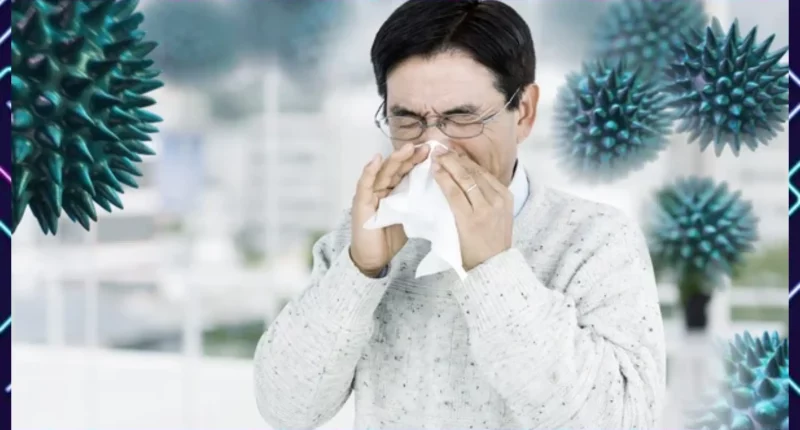One aspect of hay fever that is often overlooked is its connection to the drainage system. Hay fever is a condition characterized by an overreaction of the immune system to airborne allergens, such as pollen, dust mites, or pet dander. While In the context of hay fever, the drainage system typically refers to the nasal and sinus drainage system. This system includes the nasal passages, sinuses, and the eustachian tubes, which connect the nasal cavity to the ears.
Unlike illnesses caused by viruses or bacteria, such as the common cold, hay fever does not spread from person to person. Therefore, you cannot catch hay fever from someone else. The symptoms may mimic those of a cold, but they arise from an allergic response rather than an infectious agent
According to the National Institutes of Health, when a person with hay fever is exposed to an allergen, their immune system releases histamine and other chemicals to fight off the perceived threat. This causes the nasal and sinus tissues to swell, leading to increased mucus production. The excess mucus can then block the drainage system, causing a buildup of pressure and discomfort, WebMD wrote.
You can also learn about the Seven Best Immune-Boosting Drinks to Fight Off Sickness
Cleaning the Drainage System
One way to alleviate hay fever symptoms is by keeping the drainage system clean. This can be achieved through various methods, such as:
- Nasal irrigation: Using a neti pot or a saline nasal spray to flush out excess mucus and allergens from the nasal passages, Food and Drug Administration report.
- Steam inhalation: Breathing in warm, moist air can help loosen mucus and clear the nasal passages.
- Decongestant sprays: Using over-the-counter decongestant sprays can help reduce nasal inflammation and improve drainage, but they should not be used for more than three days in a row.
Keeping the Drainage System Clean
To maintain a healthy drainage system, it is important to practice good hygiene and avoid exposure to allergens. Some tips include:
- Using a HEPA air purifier to remove airborne allergens from the home.
- Regularly washing bedding and curtains to remove dust mites and other allergens.
- Avoid triggers, such as smoke, strong scents, and changes in temperature or humidity.
- Staying hydrated by drinking plenty of water to thin out mucus and promote drainage.
Tips for a Better Drainage System
In addition to cleaning and maintaining the drainage system, there are several other steps you can take to improve its function and alleviate hay fever symptoms:
- Practicing stress management techniques, such as meditation or deep breathing, as stress can exacerbate hay fever symptoms.
- Considering immunotherapy or allergy shots, can help desensitize the immune system to specific allergens.
- Consult with a healthcare professional to determine the most effective treatment plan for your individual needs.
- To ensure hygienic drainage, always insulate and seal the existing crawl space to prevent air leaks. Be sure to block off any supply ducts that lead into the crawl space. Additionally, install an exhaust system to reduce humidity and create negative pressure in the crawl space.
Home Remedies: How Do You Stop Drainage From Allergies?
- Stay indoors with windows closed when pollen counts are high
- Use a HEPA air purifier to remove allergens from indoor air
- Wash bedding and curtains frequently to remove dust mites
- Take oral antihistamines like cetirizine or loratadine to reduce overall allergy symptoms
- Use antihistamine nasal sprays, which are most effective when started before
- allergy season begins
- Apply antihistamine eye drops to reduce eye itching and inflammation
- Use a neti pot or saline nasal spray to flush out mucus and allergens
- Saline sprays can be used long-term to keep nasal passages moist
- Drink plenty of fluids to stay hydrated, which helps thin mucus
- Use a humidifier to add moisture to dry indoor air
- Elevate your head when sleeping to help mucus drain
- Apply a cold compress to soothe itchy, irritated eyes
- Avoid rubbing your eyes, as this can worsen irritation.
How Long Does Drainage from Allergies Last?
The duration of drainage from allergies can vary significantly based on individual circumstances and the specific allergens involved. For those with seasonal allergies, such as hay fever, drainage may persist throughout the pollen season, which can last several weeks to months, depending on the type of pollen and geographical location.
Individuals with year-round allergies may experience ongoing drainage as long as they are exposed to allergens like dust mites, pet dander, or mold. This can lead to chronic symptoms that last indefinitely without proper management.
In many cases, clear nasal drainage from allergies may resolve on its own once the allergen is removed or after a few days of treatment, but if symptoms persist for more than four weeks, it is advisable to consult a healthcare professional for further evaluation and treatment options.
To learn more about Hay Fever, check out Tubes And Bulbs Cleaning Can Help Prevent Hay Fever
References
- WebMD. Postnasal Drip: Causes, Treatments, Symptoms, and More. https://www.webmd.com/allergies/postnasal-drip
- NHS Fife. Steam Inhalation. https://www.nhsfife.org/media/e9dp0vw1/steam-inhalation-leaflet.pdf
- Mayo Clinic. Acute Sinusitis: Expert Answers. https://www.mayoclinic.org/diseases-conditions/acute-sinusitis/expert-answers/acute-sinusitis/faq









